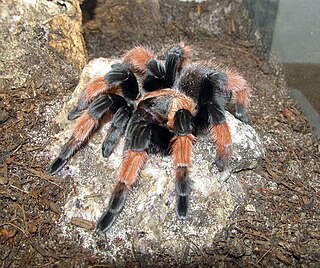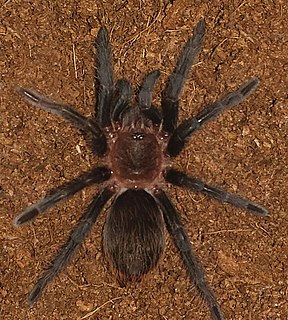
The Goliath birdeater belongs to the tarantula family Theraphosidae. Found in northern South America, it is the largest spider in the world by mass – 175 g (6.2 oz) – and body length – up to 13 cm (5.1 in) – but it is second to the giant huntsman spider by leg span. It is also called the Goliath bird-eating spider; the practice of calling theraphosids "bird-eating" derives from an early 18th-century copper engraving by Maria Sibylla Merian that shows one eating a hummingbird. Despite the spider's name, it only rarely preys on birds.

Avicularia is a genus of the family Theraphosidae containing various species of tarantulas. The genus is native to tropical Central and South America. Each species in the genus has very distinguishable pink foot pads.

Brachypelma is a genus of spiders in the family Theraphosidae (tarantulas). They may have bodies up to 6 cm long with legs of similar or greater lengths. Some species have brightly colored legs, with red or orange marks and rings.

Dolichothele is a genus of spiders in the family Theraphosidae found in Brazil and Bolivia. It was first described in 1923 by Mello-Leitão. As of 2017, it contains 8 species.

Tarantulas comprise a group of large and often ″hairy″ spiders of the family Theraphosidae. Currently, about 1,000 species have been identified. The term tarantula is usually used to describe members of the family Theraphosidae, although many other members of the same infraorder (Mygalomorphae) are commonly referred to as "tarantulas" or "false tarantulas". Some of the more common species have become popular in the exotic pet trade. Many New World species kept as pets have urticating hairs that can cause irritation to the skin, and in extreme cases, cause damage to the eyes.

Brachypelma albiceps is a species of spider in the tarantula family, Theraphosidae. It is known as the Mexican golden red rump tarantula or the Amula red rump tarantula. The carapace is a light golden color and the abdomen dark, covered with long red hairs. Females typically live for about 15 years. Males usually live about 5 years or up to 12 months after the last molt.

The Malaysian earthtiger tarantula, scientific name Omothymus schioedtei, is a species of spider in the family Theraphosidae (tarantulas), found in Peninsular Malaysia. It is also known by the synonym Cyriopagopus schioedtei.

Aphonopelma iodius is a species of spider in the tarantula family Theraphosidae, found in United States. A 1997 paper combined it with three other previously described species into a single species, calling it "A. iodium". However, iodius is a neuter comparative adjective and is the correct form. Aphonopelma smithii has also been synonymized with A. iodius. A. iodius is common in the Mojave Desert to the west of the Colorado River. As of 1997, the distribution of A. iodius farther south or west into the Mojave Desert or North into Nevada and Utah was undetermined.
Cardiopelma is a genus of spiders in the family Theraphosidae. It was first described in 1999 by Vol. As of 2017, it contains only one species, Cardiopelma mascatum, with an unknown distribution.
Crassicrus is a genus of Central and South American tarantulas that was first described by S. B. Reichling & R. C. West in 1996.
Longilyra is a genus of spiders in the family Theraphosidae. It was first described in 2014 by Gabriel. As of 2017, it contains only one species, Longilyra johnlonghorni, found in El Salvador.
Antillena is a genus of spiders in the family Theraphosidae (tarantulas). As of March 2017, the genus contained a single species, Antillena rickwesti, found in the Dominican Republic.

Caribena is a genus of spiders in the family Theraphosidae (tarantulas), found in the Antilles. The two species accepted as of March 2017 were formerly placed in Avicularia. Apart from a different distribution – Avicularia species are found in mainland South and Central America – Caribena is distinguished by having longer and thinner type II urticating hairs in a conspicuous patch on the upper surface of the abdomen. Males also have a differently shaped palpal bulb.

Caribena laeta is a species of spider in the family Theraphosidae, found in the US Virgin Islands, Puerto Rico, and Cuba, the last dubiously according to Caroline Fukushima and Rogério Bertani in 2017.

Günter E. W. Schmidt was a German arachnologist and author of a standard German work on tarantulas, Die Vogelspinnen. He has been described as one of the fathers of German arachnology.
Magnacarina is a genus of spiders in the family Theraphosidae. It was first described in 2016 by Mendoza, Locht, Kaderka, Medina & Pérez-Miles. As of 2017, it contains 4 species.
Rick C. West is a Canadian arachnologist with a main expertise toward tarantula spiders. West was born in Victoria, British Columbia. He has been interested in spiders since childhood, and collected his first tarantula, Aphonopelma eutylenum at the age of 13. He worked primarily as a Chief Constable for a local Animal Humane Society, but also have been involved with the collecting, breeding, rearing and photography of theraphosid spiders. West has traveled to over 27 countries to document and study them in their environment, has been a host, presenter and co-producer in several tarantula documentaries and has also described several new species.

Tliltocatl verdezi is a species of spiders in the family Theraphosidae (tarantulas), found in Mexico.

Avicularioidea is a clade of mygalomorph spiders, one of the two main clades into which mygalomorphs are divided. It has been treated at the rank of superfamily.












